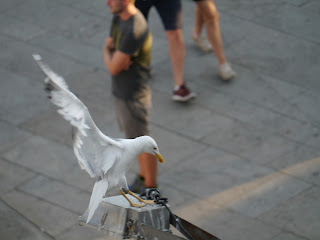You may (or may not) have noticed that my blog posts are not as frequent as they have been in the past. The simple reason is school work, as I am now in the final year of my GCSEs, so school work and revision is my main focus at the moment.
However, everyone needs a birding break from work.
The last few weeks at my local patch Winsford Flash have been great and have included scarce species such as Caspian Gull, Sandwich Terns and a Yellow Legged Gull all passing through.
Caspian Gull at Winsford Flash
There have been a few waders too, but I have been missing seeing those big flocks of waders and the variety that you can get in some locations. So I was determined to get to Frodsham Marsh today and enjoy some wader watching. I wasn't bothered about chasing anything new, I just wanted to enjoy the spectacle of big numbers of waders. And I wasn't disappointed.
On the walk to No.6 Tank there were 2 kestrels hunting over the paddocks and several Chiffchaff calling from the hedgerows. The water in the ditch was covered in weed, but you could see trails through it where the Moorhens had half clambered, half swam through it. An arable crop yet to be harvested had attracted a big group of Reed Bunting and there were large flocks of Meadow Pipit flying overhead.
As we got closer to No. 6 tank several large flocks of Canada Geese flew over and large groups of Starlings were feeding in the fields.
No. 6 Tank itself held a feast for your eyes. I counted counted 3 Snipe, 110 Black-tailed Godwit, 3 Little Sint, 1 Golden Plover, 200 Lapwing, 150 Black-headed Gull, 2 Lesser Blacked Backed Gull, 7 Common Gull, 3 Redshank, 28 Ruff, 18 Pintail and 11 Wigeon.
Something (I didn't see what) spooked all the birds and they took to the air in a huge flock, but staying in their unique groups to form layers of different species low over the water. The various duck species stayed closest to the water, whilst the gulls formed a middle layer as the Lapwing danced above the others putting out their alarm calls.








